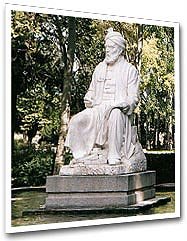 FERDOSI, THE GREAT
FERDOSI, THE GREATToday, Persians and the world reminisced about the great philosopher Ferdosi. In Tehran University and Ferdosi university in Mashhad , there was conferences in memory of him. That’s a pity we couldn’t participate. But for remembrance of this great man we decided to write some words since we, Persians, owe him our language and culture a lot. May he be ever remembered! And he would …
Ferdosi's life(taken from a site which you can see the address at the end of the article)
Ferdosi mentions the exact date for his sixty-third birthday in the Shahnameh. After reconciling the calendar he used with the ones still in use today, it’s been determined that he was born on Friday January 3rd, 940 A.D. (329 A.H., lunar calendar). His birthplace, Bazh, was a village in the neighborhood of Tabaran, the main district of the old city of Tus, in the province of Khorasan, Iran.
His honorific title (konye) is unanimously recorded as Abu’lQassem, which indicates that he had a son named Qassem. His son’s death at a young age grieved the poet immensely. According to Nezami-Aruzi, Ferdosi left behind only a daughter – a high-spirited lady…
For Centuries after the fall of the Sassanian (the last Iranian dynasty overthrown in the Arab invasion of the seventh century A.D.), the dehqans remained pillars of the Iranian community. They endeavored to preserve the memories of the golden days of the perished empire. They upheld the heroic traditions and the cultural heritage of Iran. Consequently, they became the paragons of the Iranian people. The very term dehqan became synonymous with “Iranian”, and the “learned narrator of history and sagas” of Iran.

Ferdosi came from this class, the landed nobility. Although his early years are obscure, being the son of a well-to-do squire, he undoubtedly received a high education and a strenuous physical training. The type of education and training which the sons of Iranian nobility would traditionally undergo. It is evident from his masterly creation, the Shahnameh that his educational concentration was on the Persian literature, and the Iranian history & sagas. He learned a great deal about ancient Iran and its heroes, culture, and heritage.
In 360/970, Ferdosi, then thirty years old, was an accomplished poet, married, with a two-year old son. He had a number of celebrated friends; among whom Mansur, the son of Abu Mansur Mohammad Abd-al-Razzaq, occupied a special position. Ferdosi’s life was filled with efforts to learn incessantly and attending the learned gatherings. He had a profound appreciation for beauty, especially natural beauty. This combined with his astonishing imagination made him an artist whose descriptions of the scenes are as colorful, as lively, and as absorbing as the great work of a master painter of the Realism School.
Ferdosi was a tall figure with a lively and optimistic nature. He lived much in the same way, as did his Sassanian ancestors, with prosperity and joy. He enjoyed such pastimes as horseback riding, playing games, feasting and drinking wine, and listening to music and songs. He loved life and all it had to offer. He was courteous, kindhearted, truthful, open-handed, warm, and faithful. He d
 espised prejudice, ignorance, and greed. Ferdosi’s personality is well reflected in his work.
espised prejudice, ignorance, and greed. Ferdosi’s personality is well reflected in his work.He admired wisdom sincerely. For Ferdosi, “truth” and “wisdom” were the keys to salvation. He emphasized that in moments of defeat and decline, hope must be retained; because old fallen trees can grow anew if their roots are preserved. This is one reason why he wanted to preserve the memories of Iran’s glorious past – which someday it might rise again. It was as if his love for Iran was part of his religion and governed his way of thinking. He idolized Iranian heroes, glorified their ways of life, and defended their traditions with zeal and conviction.
Ferdosi spent his best years pouring his energy and heart into charming, meaningful, and exciting poetry. The Shahnameh is an impressive monument of poetry and historiography; a poetical recast of what Ferdosi and his predecessors regarded as the account of Iran’s history. The singular message that the Shahnameh strives to convey is the idea that the history of Iranshahr was a complete and immutable whole. It started with Gayumarth, the first man, and ended with his fiftieth scion and successor, Yazdegerd III: six thousand years of history. The task of Ferdosi was to prevent this history from losing its connection with the future Iranian generations. Needless to say, he succeeded in a way that no other historian has, either before or after him.
As a man of strong principles, Ferdosi kept the Shahnameh undedicated for a long time. In all the years he was composing the Shahnameh, he had saved it for a royal patron who would recognize the value of such a treasure and would be worthy of receiving it. Such patron would ensure preservation of copies of the Shahnameh, and would help to propagate them throughout Iran.
For more information go to:http://www.ferdosi.org/WWW/ferdosimain.html
http://www.farhangsara.com/ferdosi1.htm
http://en.wikipedia.org/wiki/Ferdowsi
0 Comments:
Post a Comment
<< Home